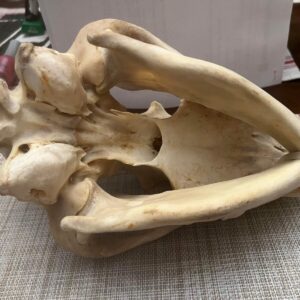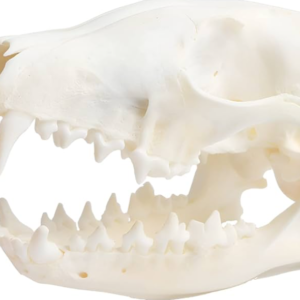Description
Real Eastern Red Bat Skull For Sale
Explore the unique Real Eastern Red Bat Skull For Sale. Learn about its structure, teeth, and adaptations for insectivorous feeding in our detailed guide.
The Eastern Red Bat (Lasiurus borealis) is a solitary, tree-dwelling bat found across North America, particularly in forests and woodlands. Known for its reddish-brown fur, it camouflages well with autumn leaves. Eastern Red Bats are insectivores, primarily feeding on moths, beetles, and other flying insects, which they hunt during the evening. Unlike many other bats, they often roost in tree foliage rather than caves. They are migratory and hibernate in leaf litter or tree cavities during winter. These bats play a vital role in controlling insect populations.
Delving into the Darkness: The Enigmatic Allure of the Red Bat Skull
The natural world holds a morbid fascination for many, and among the macabre curiosities that captivate the imagination, the red bat skull stands out as a particularly intriguing and enigmatic specimen. More than just bone, it’s a symbol of nocturnal mystery, delicate beauty, and the often-overlooked complexity of the natural world. But what makes the red bat skull so captivating, and what can it tell us about the creature it once housed?
The Red Bat: A Glimpse into the Life of a Nocturnal Hunter
Before examining the skull itself, it’s crucial to understand the animal it belonged to. The red bat (Lasiurus borealis) is a common, yet often unseen, resident of North America. True to its name, this bat boasts a vibrant, reddish-brown fur coat, providing excellent camouflage amongst the autumn foliage where it often roosts. Unlike many other bat species, red bats are solitary creatures, preferring to roost alone in trees, hidden amongst the leaves.
They are primarily insectivores, emerging at dusk to hunt moths, flies, and other flying insects. Their agility in flight is remarkable, allowing them to navigate through dense forests and capture their prey with precision. Knowing this about the living animal provides context for understanding the structure and function of its skull.
Unveiling the Secrets of the Skull:
The skull of a red bat, like that of all animals, is a marvel of biological engineering. Examining a red bat skull, particularly one that has naturally aged and bleached, can reveal a surprising level of detail:
- Delicate Structure: Bat skulls, in general, are remarkably lightweight and delicate. This reflects their need for agility and maneuverability in flight. The bones are thin and porous, minimizing weight without sacrificing strength.
- Dental Power: Despite their small size, red bats possess sharp, pointed teeth perfectly adapted for capturing and consuming insects. Observing the shape and arrangement of these teeth provides insight into their diet and hunting strategies.
- Enlarged Auditory Bullae: The skull features large, prominent auditory bullae, the bony casings that protect the inner ear. This is a testament to the importance of echolocation for bats. Their reliance on sound for navigation and hunting has shaped the evolution of their skull.
- Orbital Sockets: The size and placement of the eye sockets offer clues about the bat’s vision capabilities. While they primarily rely on echolocation, bats also possess some ability to see, especially in low light conditions.
The Allure of the Red Bat Skull:
Beyond the anatomical details, the red bat skull possesses a unique allure that draws people in. This fascination stems from several factors:
- Symbolism of the Bat: Bats are often associated with darkness, mystery, and the supernatural. The skull, as a representation of death, amplifies these symbolic meanings, creating a sense of intrigue and the unknown.
- Rarity and Accessibility: Finding a complete and well-preserved bat skull is not easy. Living bats are protected in many areas, and their small size and fragile bones make them difficult to locate after death. This rarity adds to their collectability and perceived value.
- Artistic Inspiration: The delicate beauty of the bat skull has inspired artists and crafts enthusiasts. It’s often used in jewelry, sculptures, and other macabre art forms, highlighting its unique form and texture.
Ethical Considerations:
While the allure of collecting and possessing a red bat skull is undeniable, it’s crucial to consider the ethical implications. It’s essential to ensure that any specimen is obtained legally and ethically, respecting wildlife conservation efforts. Avoid purchasing or collecting bat skulls from areas where they are protected, and prioritize ethically sourced specimens, such as those found through natural decomposition.
Conclusion:
The red bat skull is more than just a piece of bone; it’s a window into the life of a fascinating and often misunderstood creature. Its delicate structure, specialized features, and symbolic associations make it a captivating object for collectors, artists, and anyone interested in the natural world. By appreciating its beauty and understanding its significance, we can gain a deeper appreciation for the intricacies and mysteries of the wild world around us. Just remember to approach this fascination with respect and a commitment to ethical and responsible practices.








Reviews
There are no reviews yet.